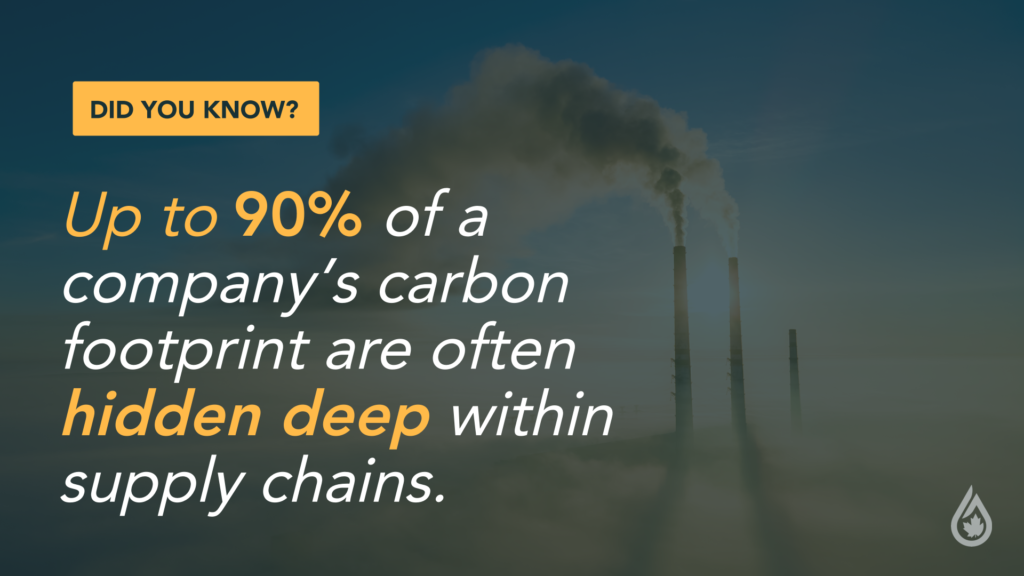Using AI and LCA Software for Emissions Tracking
Corporations are already navigating rigorous environmental standards, but one hurdle remains daunting – how to pinpoint hidden emissions within intricate, multi-tiered supply chains. For sustainability leaders striving for precision, transparency, and innovation in emissions tracking, using AI and LCA software for emissions tracking are emerging as essential tools. With these technologies, sustainability executives can better understand, measure, and ultimately reduce their supply chain emissions, especially the elusive Scope 3 emissions that account for a significant portion of a company’s carbon footprint.
Scope 3 emissions often span across global supply chains, reaching numerous layers of suppliers, making tracking a formidable task that requires advanced technology for accuracy.
Understanding Scope 3 Emissions
Scope 3 emissions, encompassing everything from purchased goods to transportation, present a unique challenge. These emissions often span across global supply chains, reaching numerous layers of suppliers. (For more on Scope 3 emissions, visit the GHG Protocol’s Scope 3 resource). This complexity makes tracking Scope 3 emissions a formidable task, requiring advanced technology capable of processing large volumes of data while maintaining accuracy. For forward-thinking sustainability leaders, the challenge lies not just in accessing data but in uncovering hard-to-detect emissions across supplier networks. Here, AI and LCA software become crucial.
The Role of AI in Emissions Detection and Reporting
Using AI and LCA software for emissions tracking have expanded rapidly, offering sustainability leaders powerful tools to make emissions tracking both scalable and insightful. Advanced AI algorithms excel at analyzing complex datasets across disparate sources, making it easier to identify emissions patterns and hotspots in supply chains. Here are three critical ways AI and LCA software will revolutionizing emissions detection:
Data Aggregation and Analysis
AI’s capacity for big data aggregation enables companies to analyze data from multiple suppliers, spanning different regions and operational scopes. By synthesizing disparate datasets, AI and LCA software for emissions tracking provide a comprehensive view of emissions sources, identifying trends and anomalies that would otherwise remain hidden.
Predictive Analytics for Emissions Estimation
Leveraging historical data, AI-driven predictive models help estimate emissions even when direct data is unavailable. These models use machine learning to make accurate predictions based on similar scenarios, a critical advantage in supply chains where direct emissions data from suppliers may be scarce or unreliable. Predictive analytics from AI and LCA software provide sustainability leaders with much-needed insights.
Real-time Monitoring and Alerts
AI enhances real-time monitoring capabilities, allowing sustainability leaders to track emissions fluctuations as they happen. This real-time tracking ensures that corporations can quickly identify shifts in their emissions profile and make prompt adjustments to align with sustainability targets. By using AI-powered analytics within carbon-neutral cloud environments, companies gain up-to-the-minute insights into their operational impact. This is where using AI and LCA software for emissions tracking shine, enabling faster, data-driven decisions that support sustainability goals.
AI-powered LCA software can automate data collection and analysis, providing sustainability leaders with near-real-time insights into emissions across their supply chains.
Advanced LCA Software: The Backbone of Modern Emissions Tracking
While AI provides the intelligence layer, LCA software for emissions tracking serves as the structural backbone. LCA tools allow corporations to evaluate the environmental impact of each product life cycle phase, from raw material extraction to disposal. For sustainability leaders, this software enables a granular view of emissions at each step in the supply chain, providing the insights needed to target specific reduction efforts effectively.
However, using AI and LCA software for emissions tracking has its challenges, particularly in terms of data accuracy and interoperability with other platforms. Here’s how advanced LCA solutions, integrated with AI capabilities, address these issues:
Ensuring Data Accuracy
Data inaccuracies can severely impact emissions tracking. Modern LCA tools, powered by AI, use machine learning algorithms to identify and correct data inconsistencies. They automatically adjust for anomalies, providing a more reliable picture of emissions levels and enhancing data accuracy.
Achieving Interoperability Across Platforms
For accurate, consolidated emissions reporting, seamless integration between platforms is essential. Using AI and LCA software for emissions tracking enable data to flow smoothly across various systems, breaking down information silos and providing a unified view of emissions data. This interoperability helps sustainability leaders streamline data collection, ensuring consistency and enhancing the quality of insights generated from multiple sources.
Automating Life Cycle Assessment for Greater Precision
AI-powered LCA software for emissions tracking can automate the time-consuming data collection and analysis phases, making it feasible for corporations to conduct in-depth assessments across various products and suppliers. Automated assessments provide sustainability leaders with a near-real-time snapshot of emissions, facilitating quick adjustments to meet evolving regulatory standards and corporate targets.

Overcoming Barriers to AI and LCA Implementation
Despite the transformative potential that materializes when using AI and LCA software for emissions tracking, organizations often face barriers in implementing these solutions. Below are some common challenges and actionable strategies for overcoming them:
Data Accessibility and Quality
Many organizations lack direct access to supplier data, making emissions tracking incomplete or unreliable. To address this, companies can engage suppliers through collaborative programs that encourage data sharing. Additionally, AI and LCA software can help by filling data gaps through predictive modeling, generating reliable estimates in the absence of supplier-provided data.
Budget Constraints for Advanced Technology Adoption
Implementing AI and LCA software for emissions tracking can require significant investment. For corporations hesitant about costs, incremental adoption may be more feasible. Start by deploying AI solutions in high-emission areas within the supply chain and then expand as the benefits become evident.
Skills Gap in AI and Data Science
Effective AI implementation requires specialized skills in data science and machine learning. Corporations can overcome this gap by upskilling their workforce through training programs or by partnering with external experts.
The Competitive Edge of Using AI and LCA Software for Emissions Tracking
For large corporations, using AI and LCA software for emissions tracking not only helps in meeting sustainability goals but also provides a competitive advantage. Companies that can track and reduce their emissions effectively are more likely to appeal to environmentally-conscious consumers and investors, positioning themselves as sustainability leaders in their industries.
Actionable Steps for Sustainability Leaders
To capitalize on the benefits of using AI and LCA software for emissions tracking, here are immediate actions sustainability leaders can take:
Engage with Technology Providers for Integrated Solutions
Partnering with cloud providers that prioritize sustainability can greatly simplify emissions tracking across complex, multi-layered supply chains. Many of these providers offer carbon-neutral platforms equipped with AI-driven tools tailored for precise emissions monitoring and management. By leveraging such integrated solutions, companies gain access to customized sustainability tools and expert support.
Implement Pilot Programs to Track High-Impact Areas
Start with a pilot program that targets high-emission products or regions within your supply chain. This focused approach allows for early wins, demonstrating the value of using AI and LCA software for emissions tracking.
Collaborate with Supply Chain Partners
A transparent and collaborative relationship with supply chain partners is essential. Encourage suppliers to adopt emissions tracking tools and share data regularly. Leveraging cloud-based platforms facilitates easier collaboration, ensuring all partners are aligned toward sustainability goals.
Regularly Update and Calibrate AI Models
As regulations and market conditions change, AI models need regular updates. Ensure your AI and LCA software for emissions tracking tools are calibrated to reflect the latest data, regulatory requirements, and market dynamics.
The Path Forward
As sustainability regulations tighten and stakeholder demands grow, AI and LCA software are becoming indispensable for corporations aiming to maintain a competitive edge. By adopting these tools, sustainability leaders gain a clearer view of their emissions landscape and build resilience and agility into their operations.
Download our Scope 3 Emissions supplier engagement toolkit and start collecting the accurate data that you need to be successful!


